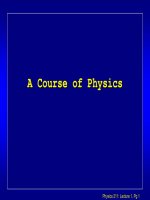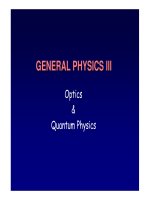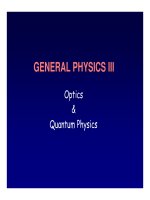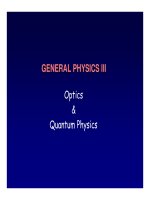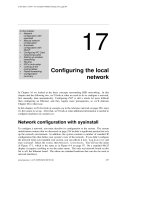- Trang chủ >>
- Khoa Học Tự Nhiên >>
- Vật lý
Tài liệu Chapter XX Quantum theory of light pdf
Bạn đang xem bản rút gọn của tài liệu. Xem và tải ngay bản đầy đủ của tài liệu tại đây (1.22 MB, 25 trang )
GENERAL PHYSICS III
GENERAL PHYSICS III
Optics
&
Quantum Physics
Chapter XX
Chapter XX
Quantum theory of light
Quantum theory of light
§1. Blackbody radiation. Planck’s theory of radiation
§2. Photoelectric effect. Einstein’s theory of light
§3. Compton scattering
At the end of the 19-th century, physics was at its most confidence
situation. Classical phyics, as formulated in Newton’s law of mechanics
and Maxwell’s theory of electromagnetism, have proved very successful
in solving every problem.
→ At that time there seemed to be no question for which physics co
uld
not provide an answer !!!
But then it came as a great shock when some simple phenomena were
observed which could not be explained by classical physics
→ a new theory, quantum theory, was developed at the beginning of the
20-th century
We begin our study of quantum physics by two following phenomena:
• Blackbody radiation
• Photoelectric effect
We will see what were the failures of classical physics and how a new
theory had been developed.
§1. Blackbody radiation. Planck’s theory of radiation:
• Heat bodies emit electromagnetic radiation in the infra-red region of the
spectrum (see the next slide). In this region the radiation is not visible.
• As the temperature of a body is increased to any value, the body begins
to glow red and then white, emitting visible electromagnetic radiation.
(an example is the variation of the radiation of a filament of electric lamp
when the electric current varies).
• Observation of the spectrum emitted by a solid shows that the radiation
extends over a continous range of frequency. Such a spectrum is called
a continuum.
1.1 Experimental laws of blackbody radiation:
1.1.1 Stephan-Boltzmann law:
• It was observed that the intensity of the radiation emitted from a
body increases rapidly with increasing temperature of the body.
formula:
I = T
4
,
where I → the average power of radiation per unit surface area,
→ a fundamental physics constant called the Stephan-Boltzmann
constant = 5,67 x 10
-8
W m
-2
K
-4
→ a dimensionless number (0 < < 1) called the emissivity, which
depends on the nature of the radiating surface.
It is found that for any surface the absorption is the exact
reverse of the emission process. It means that the ability of
emission is proportional to that of absorption:
→ 0, the surface has low emissivity and low ability of absorption
→ 1, the surface has high emissivity and high ability of absorption
The idealized case, when = 1, such a body is called absolute blackbody.
A blackbody absorbs completely all the incident radiation and gives no
reflecting radiation (that is why the body is black !).
• Therefore we have for a blackbody: I = T
4
This is the Stephan-Boltzmann law for a blackbody
• Remark: For a blackbody the total intensity
depends only on absolute temperature
• A cavity with a small aperture is an example
of a blackbody. Electromagnetic radiation
entering the cavity is eventually absorbed
after successive reflections → the cavity is
a perfect absorber of e-m radiation.
1.1.2 Wien displacement law:
Note that the intensity I in the Stephan-Boltzmann is the total intensity,
that is, the radiation intensity for all wavelengths.
Denote by I() dthe intensity corresponding to wavelengths in the
interval and + dwe can write
0
)(
dII
I() is the distribution function
over all wavelengths. It is called
the spectral emittance.
• The form of I() depends on
temperature. By experimental
measures one has I
T
() shown
in the picture.
• Each curve has a peak at =
m
It is observed that as the
temperature T increases, the
peak grown larger, and shifts to
shorter wavelengths.
• By experiment Wien showed
that
m
is inversely proportional
to T, and
m
T = 2.90 x 10
-3
m.K
This is Wien displacement law
1.2 Rayleigh–Jeans formula . Ultraviolet catastrophe:
• Rayleigh and Jeans attemped to explain the observed blackbody spectrum
on the base of the concept that radiation is a e-m wave. They derived the
following formula for the intensity distribution:
4
2
)(
ckT
I
I
T
()
• Comparing the Rayleigh-Jeans
spectrum with experiment one
can see that:
The R-J formula agrees well
with experiment at large
But there is a serious
disagreement at small
The unrealistic behavior of
the Rayleigh-Jeans distribution
at short wavelengths is known in
physics as “ultraviolet catastrophe”.
A more impressive indication of the complete failure of the Rayleigh-
Jeans spectrum is the result on the total intensity:
3
0
0
4
0
1
lim
3
2
2)(
ckTd
ckTdII
It means that I → , an unceptable result !!!
The blackbody radiation spectrum could not be explained
by classical physics
1.2 Planck’s theory of radiation:
The discrepancy between experiment and theory was resolved in 1900
by Planck, by introducing a postulate which was revolutionary with
respect to certain concepts of classical physics.
Planck’s postulate: “
Electromagnetic radiation consists of simple harmonic
oscillations which can possess only energies
= nh (n = 0, 1, 2, 3, ….)
where n is the frequancy of the oscillation, and h is an universal constant”
Energy level diagrams for classical sipmple harmonic
oscillations and for that obeying Planck’s postulates.
The constant h is called the Planck constant. It’s value was determined
by fitting theoretical consequences with experiment data (see below).
1.2.1 Planck’s postulate and radiation law:
With this postulate Planck derived the following spectrum distribution
function
1
2
)(
/5
2
kThc
e
hc
I
Planck radiation law
1.2.2 The agreement of the Planck law with experiment:
The Wien displacement law could be derived from the Planck law:
This coincides with the Wien displacement law,
if the value of h satisties the equation
Km
k
hc
.109.2
965
.
4
3
The Stephan-Boltzmann law is also a consequence of Planck law:
(*)
4
32
45
0
15
2
)( T
hc
k
dII
→ h must
satisfy
428
32
45
/1067.5
15
2
KmW
hc
k
0
)(
d
dI
The transcendent equation
Tk
hc
m
1
.
965.4
is solved numerically,
(**)
I
T
()
The comparison of Planck’s spectrum
with experiment at T = 1646
0
K
Equations (*), (**) and
fits the Planck law curve
with experiment leads to
the same result for the value
of the Planck’s constant:
h = 6.626x10
-34
J.s
Therefore, the experimental
laws for blackbody radiation
could have a satisfactory
explanation with the Planck’s
theory. The root idea is that
electromagnetic energy
emitted by bodies can have
only discrete values n.h
→ one say that energy is
quantized. The discrete nature
of energy is the foundation of quantum theory.
One more remark: The large wavelength limit of the Planck’s spectrum
formula is the Rayleigh’s formula (recall e
x
≈1 + x with small x). This means
that at very long wavelengths (very small quanta energies), quantum effects
become unimportant.
§2.Photoelectric effect. Einstein’s theory of light:
Binding
potential
2.1 Photoelectric effect:
If you shine light on the metal surface, electrons absorb energy from
the incident light, and have enough energy to escape. Eshtablish on the
metal surface a electric field → the escaped electrons create an current
that is called photoelectric current
How will the photoelectric current depend on the intensity I and
the frequency of the incident light ?
Consider a metal surface. Electrons in
a metal are “bound” by the binding
potential energy. Introduce the
quantity , called “work function”.
is the minimum amount of energy an
induvidual electron has to gain to escape:
• E < → the electron is confined inside metal
• E > → the electron can escape from metal.
(E: the energy
of the electron ).
Experiment 1: Measure the maximum
energy of ejected electrons
The electric field between the
“collector” and the metal will
repel ejected electrons
Increase negative voltage until
flow of ejected electrons
decreases to zero.
(Current = 0 at V = V
stop
)
Measurement of V
stop
tells the max
kinetic energy of electrons
K
max
= eV
stop
.
The result:
It means that increasing the intensity I does not increase kinetic
energy of electrons !
The “stopping voltage” is independent of light intensity I !
Incident Light
(variable frequency )
+
V
Collector
Metal Surface
electrons
vacuum
A
Experiment 2: Measure the maximum energy vs.
The results:
Stopping voltage V
stop
(and the maximum kinetic energy of electrons)
decreases with decreasing (linear dependence).
Below a certain frequency
o
, no electrons are emitted, even for intense
light!
Incident Light
(variable frequency )
+
V
Collector
Metal Surface
electrons
vacuum
A
V
stop
()
(x10
14
Hz)
0
1
2
3
0 5 10 15
f
0
0
Summary of results:
Energy of electrons emitted depends on frequency, not intensity
Electrons are not ejected for frequencies below
0
Electrons are emitted as soon as any light with
V
stop
()
(x10
14
Hz)
0
1
2
3
0 5 10 15
f
0
h/e
1
slope
+
V
Collector
Metal Surface
electrons
vacuum
A
0
This results are hard to understand on the basis of classical physics !
(According to classical physics: if the light intensity increases, electrons
gain more energy → have more chance to escape. Don’t understand why
is there a limit frequency
).
2.2 Einstein’s quantum theory of light:
To overcome the difficulty of classical physics, Albert Einstei
n introduced
the quantum theory of light, and developed the correct analysis of the
photoelectric effect in 1905.
2.2.1 Einstein’s postulates:
By analogy to the earlier Planck’s theory of radiation, the postulates of
Einstein’s theory is as follows:
Light consists of small “packages” of energy called photons or
light quanta.
The energy of a photon is = hwhere h is the Plank constant.
In vacuum = h= hc/
2.2.2 Analysis of the photoeffect by the quantum theory:
A photon arriving at the surface is absorbed by an electron (one by one).
After that the electron gets all the photon’s energy (h)
For an electron we can write the following equation:
2
v
2
max
m
h
The energy of the electron
after absoption of photon
The energy part
for escaping from
the metal surface
The remaining part, the kinetic
energy of the motion outside metal
Kinetic energy of the electron outside metal is telled by the value V
stop
in the experiment:
stop
eV
m
K
2
v
2
max
max
heV
stop
By this analysis it is understandable that
• Energy of electrons emitted depends on frequency, not intensity
• The limit frequency
0
for the photoeffect is determined by the
equation h
0
=
Under this light frequency the electron has not
enough energy to escape.
§3. Compton scattering:
Compton scattering (Compton effect) is a phenomenon that provides
additional direct confimation of the quantum nature of light, and
particularly, of X-rays.
3.1 Experimental results:
• The wavelength of the
incoming monochromatic
X-rays:
• The wavelength of the
scattering X-rays: ’
Experimental observations
discovered a shift in wavelength: ’ ≠
The wavelength shift of scattered X-rays is called the Compton effect.
• It is found that the wavelength difference ’ - varies with
the scattering angle
according to the equation
(A.H. Compton 1923).
See the graph of the
intensisties of the
scattered X-rays,
plotted as a function
of wavelength at
a) = 45
o
; b) = 90
o
a)
b)
According to classical physics, electrons in the target oscillate in the
electromagnetic field of the incident X-rays → their oscillation produces
radiation with the same frequency (the same ) with the incident X-rays.
The Compton effect could not be interpreted by classical physics !!
But on the basis of the photon model of light one has a satisfactory
explanation of this effect.
3.2 Compton effect as the result of photon-electron collision:
On the basis of the photon model of light, we
consider the Compton scattering as the
following collision process
+ e → ’ + e’
and e -
photon and electron before collision;
’ and e’ - photon and electron after collision
• Regarding a photon as a particle with energy E
and momentum p, we have from the theory of
relativity
• The conservation of the total momentum vector
gives
e
ppp
'
Photon momentum
before scattering
Photon momentum after scattering
Electron momentum
after scattering
Photon has the rest mass m = 0, so we have
h
c
h
c
E
p
cos'2'
222
ppppp
e
• The conservation of the total energy gives
ee
Ecpcmpc '
2
0
2
2
22
2
2
0
' cpcmEcmcppc
eeee
(*)
(**)
• Combining (*) and (**) we can eliminate p
e
and obtain
cos1
'
p
cm
p
cm
ee
h
p
cos1'
cm
h
e
This equation agrees well with experiment.
Therefore, together with the phenomena of blackbody radiation and
the photoeffect, the Compton effect gave a more evidence for the
“particle” nature of light.
Review
Review
At the end of 19-th century classical physics encountered a serious
challenge: the experimental laws for the blackbody radiation could not be
understood by the concepts of classical physics.
In 1900 Planck introduced his hypothesis about the discrete nature of
radiation energy. He stated that energy can be emitted in the form of
energy quanta, each quantum is h
Planck’s theory gave the consequences that agree well with the
experimental laws for the blackbody radiation.
Planck’s hypothesis is recognised as the beginning of a new theory, the
quantum theory.
• In 1905 Einstein developed an analogue theory for light: Light consists
of photons, the energy of each photon is h
Einstein’s theory gave a satisfactory interpretation of the experimental
results of the photoeffect, which could not explained by classical physics.
In 1923 Compton observed the wavelength shift of scattered X-rays.
This effect was interpreted excelently by the photon model of light.
The formula for the wavelength shift was derived by using the
equations which express the conservation of the total energy and the
total momentum of the collision of two particles – photon and electron.
• The mentioned phenomena showed the “particle” nature of
electromagnetic waves (thermal radiation, visible light, X-rays,…).
Electromagnetic waves can be considered as flows of photons
• In the limit of large wavelengths (high frequencies, small photon
energies) quantum effects become unimportant. The “particle” behavior
of electromagnetic waves is remarkable in short-wavelength regions of
the continuum of electromagnetic waves.

